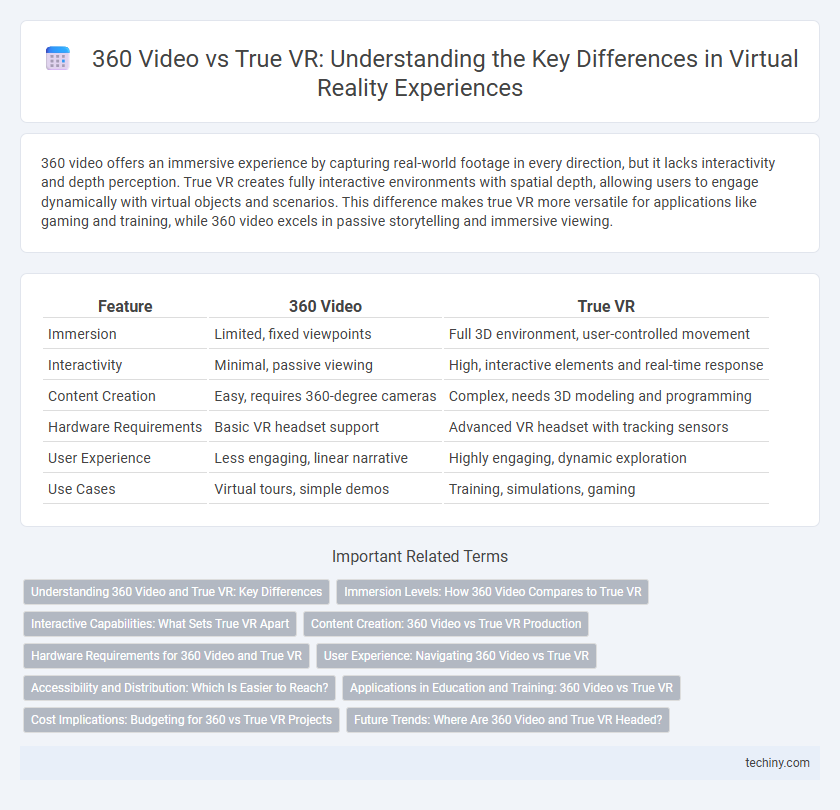360 video offers an immersive experience by capturing real-world footage in every direction, but it lacks interactivity and depth perception. True VR creates fully interactive environments with spatial depth, allowing users to engage dynamically with virtual objects and scenarios. This difference makes true VR more versatile for applications like gaming and training, while 360 video excels in passive storytelling and immersive viewing.
Table of Comparison
| Feature | 360 Video | True VR |
|---|---|---|
| Immersion | Limited, fixed viewpoints | Full 3D environment, user-controlled movement |
| Interactivity | Minimal, passive viewing | High, interactive elements and real-time response |
| Content Creation | Easy, requires 360-degree cameras | Complex, needs 3D modeling and programming |
| Hardware Requirements | Basic VR headset support | Advanced VR headset with tracking sensors |
| User Experience | Less engaging, linear narrative | Highly engaging, dynamic exploration |
| Use Cases | Virtual tours, simple demos | Training, simulations, gaming |
Understanding 360 Video and True VR: Key Differences
360 video captures real-world scenes in a spherical format, allowing users to look around but not interact with the environment, offering a passive viewing experience. True VR involves computer-generated environments with full spatial tracking and interactivity, enabling users to move and manipulate objects within a virtual space. The key differences lie in immersion levels, user agency, and the technology underpinning each experience, with True VR delivering a more dynamic and interactive sensory engagement.
Immersion Levels: How 360 Video Compares to True VR
360 video offers a fixed perspective, limiting user interaction and reducing the sense of presence compared to true VR environments, which provide full spatial freedom and real-time responsiveness. True VR immerses users by enabling dynamic navigation and object manipulation, enhancing engagement through depth perception and interactive elements. As a result, immersion levels in true VR significantly surpass those of 360 video, delivering a more convincing and participatory virtual experience.
Interactive Capabilities: What Sets True VR Apart
True VR offers immersive interactive capabilities that 360 video lacks, enabling users to engage with the environment in real-time through motion tracking and gesture recognition. Unlike 360 video, which provides a passive viewing experience limited to predetermined camera angles, True VR allows dynamic exploration and manipulation of virtual objects, enhancing user agency. This interactive depth is crucial for applications in training simulations, gaming, and virtual collaboration, where responsive environments boost realism and engagement.
Content Creation: 360 Video vs True VR Production
360 video production involves filming real-world environments using omnidirectional cameras, capturing immersive but fixed perspectives with limited interactivity, while true VR production requires creating fully interactive digital environments through 3D modeling, animation, and game engines. True VR content creation demands higher technical expertise, longer development times, and greater computational resources compared to the relatively straightforward 360 video shooting and stitching processes. The choice between 360 video and true VR content depends on the desired level of user interaction, immersion, and production complexity.
Hardware Requirements for 360 Video and True VR
360 video requires minimal hardware, typically a standard VR headset capable of video playback, as it consists of pre-recorded spherical footage without interactive elements. True VR demands advanced hardware including high-performance PCs or standalone headsets with powerful GPUs, motion tracking sensors, and hand controllers to support real-time rendering and interactive environments. The hardware disparity significantly impacts the immersive experience, with True VR enabling dynamic user interaction beyond the passive viewing of 360 video.
User Experience: Navigating 360 Video vs True VR
Navigating 360 video offers users a passive, fixed-path experience where they can look around a pre-recorded environment but lack freedom to interact or move within the space. True VR delivers an immersive, interactive user experience by enabling real-time movement, object manipulation, and spatial exploration through motion tracking and input devices. This distinction significantly impacts user engagement, with true VR promoting active involvement and presence compared to the observational nature of 360 video.
Accessibility and Distribution: Which Is Easier to Reach?
360 video offers broader accessibility by requiring only basic VR headsets or compatible smartphones, making it easier to distribute across various platforms without specialized hardware. True VR demands more advanced equipment and processing power, limiting its reach to users with high-end devices and faster internet connections. Consequently, 360 video achieves wider audience penetration due to lower technical barriers and simpler content delivery methods.
Applications in Education and Training: 360 Video vs True VR
360 video offers immersive, real-world scenarios ideal for observational learning in education and training, capturing authentic environments for student engagement. True VR enables interactive, customizable experiences allowing learners to practice skills and make decisions in simulated settings, enhancing critical thinking and problem-solving abilities. This interactivity makes True VR better suited for hands-on training, while 360 video excels in providing context-rich visual content.
Cost Implications: Budgeting for 360 vs True VR Projects
360 video projects typically incur lower costs due to simpler production workflows and the use of off-the-shelf cameras, while true VR requires significant investment in custom 3D modeling, interactive design, and software development. Budgeting for true VR must account for complex hardware requirements and ongoing updates to maintain immersive experiences, which amplify production expenses. Cost implications heavily influence project scope and scalability, with 360 video being a cost-effective entry point and true VR demanding a larger financial commitment for fully immersive environments.
Future Trends: Where Are 360 Video and True VR Headed?
360 video offers immersive panoramic views but remains limited by fixed perspectives, whereas true VR enables interactive, fully navigable environments driven by advanced motion tracking and real-time rendering. Future trends emphasize the integration of AI to enhance realism and adaptive content generation, alongside improvements in hardware such as higher resolution displays and lightweight, wireless headsets. Industry forecasts predict a convergence of 360 video and true VR technologies, creating hybrid experiences that combine photorealistic visuals with user agency for applications in entertainment, education, and training.
360 Video vs True VR Infographic

 techiny.com
techiny.com